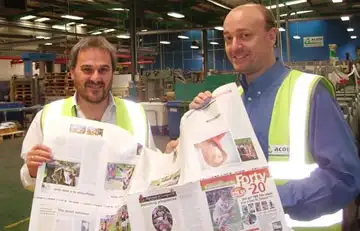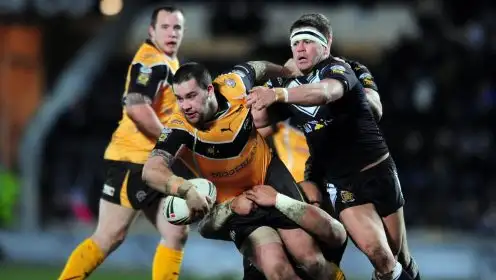Rugby League Week #15 – Rugby League – read all about it?

Shortly after this month’s Forty-20 came back from the printers – in all good stores now – I began reading a nostalgic piece about the old pink and green ‘uns.
Remember those? If you are of a similar vintage to myself (early fifties, though in certain light and home for visually impaired could pass for thirties, mental age juvenile), you almost certainly do.
If however the 1970s feel about as far off as the 1870s, virtual reality is your actual reality and the family dinner table is merely a flat surface upon which to pile your washing, pink ‘uns and green ‘uns will more likely be the stuff you and your buddies throw down your necks before a night on the town.
Well, kids (*pops in a Werther’s Original*) time was when the pink and green ‘uns that kicked off our Saturday evenings in front of Basil Brush and The Generation Game were bang up-to-date sports newspapers, published and in the shops exactly one hour after the final whistle of that day’s football matches.
I can well remember, as a kid, being sent up to Moore Avenue newsagents in Bradford to get a copy for my dad and, while there, standing among a whole group of men and boys of all ages as we waited for the van to arrive and the driver to chuck in a bundle of pink Yorkshire Sports, courtesy of the Telegraph & Argus for whom, one day, I would end up working.
It was a scene replicated across the country, I’m sure.
Locally-produced, the secret of their success, sports fans couldn’t wait to devour their classified results and reports and updated league tables – mainly, though not exclusively, a round-up of football matches and race meetings.
True, the national scores would have already been on radio or, later, television. But once that moment had passed, the information was gone – in any detail anyway – and there was something exciting and even comforting about having such events confirmed in physical newsprint, with the ink still fresh.
Building on a tradition established in the late nineteenth and early twentieth century and in particular a paper called theSporting Times (in which, incidentally, the ‘Ashes’ of England–Australia cricket games were given their spoof death notice in 1882), such papers were part of the weekly routine.
And yet, as is the way of all things, as times changed they outlived their usefulness every bit as swiftly as they had once hit the streets.
A very obvious reason for why these publications, once so loved, no longer exist – the last of their kind was theManchester Evening News-produced Football Pink in 2000 – is the world wide web (are we still calling it that?).
After all, why hang around in a newsagents waiting to get your fingers inky when all the facts you need are there, free of charge, in the devil’s window?
But the rot had begun to set in well before every house had more home computers than kettles; in the days when the only thing that went online was that aforementioned washing; and when wireless meant the wooden cabinet you listened to Two-Way Family Favourites on as your mother murdered the sprouts.
To begin with, there was the telly, whose weekly ‘Treble Chance’ pools check did away with the need to actually read that info again for those who a) could scribble it down fast enough and b) had really only bought the pink or green ‘uns to see whether or not, like Castleford’s very own jackpot winner Viv Nicholson, they would henceforth be able to spend, spend, spend.
And when in 1994 the National Lottery kicked in and the football pools themselves took a hit, that reason to buy all-but evaporated entirely. Nowadays, you can bet on the precise second of the goalkeeper’s first fart, but that of course would have to be online via your mobile telephone device or tablet.
For true sports fans, meanwhile, keen to read about how Bradford City got on at Hereford United, or collate the local rugby league or cricket scores, the arrival of Ceefax – now also extinct – and Teletext was a killer blow also.
The point being that, in sports publishing as elsewhere, seemingly commonplace items of popular culture are in fact almost entirely dependent on the whims, fashions and technological advances of the age in which they exist. If you were to set up a green ‘un today, failure would be all but guaranteed.
Not only because so many local papers aren’t actually local at all. As the feature I read (perhaps not so ironically in The Oldie) put it: ‘Scores of regional titles have either closed down or been acquired by large conglomerates with centralised print facilities, often many miles from the cities the papers serve.’
No, the main reason pink, green or sky blue pink with yellow dots on ‘uns won’t work today is that their audience has vanished. The older end has either died or is dying off (sob), and the young ones simply don’t have any use for them.
All of which begs the question, are we currently experiencing the same or at least a similar phenomenon in rugby league publishing?
Let’s be clear about this. The rugby league market has never been a particularly large one. In terms of national share, the audience we are all part of is tiny, a commercial niche – though we do well to punch above our weight on broadcasting rights and are often second only to the modern-day behemoth that is association football.
But such (vitally important) viewing figures are very often down to passing pairs of eyes on the heads of people for whom league is just one more nugget of entertainment in a life already stacked full of such distractions.
The hard-core support, i.e. those of us who lap up every last detail of what’s going on in the game, on the field and off it, is and always has been small. The difference in the past being that if you DID want to wallow in rugby league, to get into its history and politics and current affairs, there were limited ways in which to do that. And therefore less choice about how to do so.
Certainly – and particularly once the great Mancunian offices were vacated for London’s Fleet Street and beyond – the national newspapers were next to useless, covering the game barely at all and then in fleeting fashion.
Regional newspapers and, from the late 1960s BBC local radio, did much better. But because they were based in a particular area, they tended not to view the game in the round. League coverage on TV was irregular and problematic to many in terms of its clichéd presentation.
So you can see how in such an environment, publications like Rugby League Gazette, The Rugby Leaguer and, in May 1976, Open Rugby came to be gobbled up like lobby in Leigh. Such monthly magazines (and in the case of the Leaguer and its like, from the 1940s, weekly papers) became essential for those who took their favourite sport seriously and wanted to read, understand and debate the current talking points.
But so minute was the pond in which these publications fished that, however relatively popular they were, mere existence was a constant battle. Over the last century and a bit, long is the list of rugby league publications that blazed away with a trail of worthy ambition before – and often after only a couple of issues – falling to earth with a plop in the mire of economic reality.
The secret of survival, as with the clubs themselves, lay in either being propped up by a wealthier related side to the business or benevolent financier, or an ability to keep production costs trimmed to a bare minimum while maintaining the highest quality of content possible.
And even then, longevity or success, call it what you will, tended to be temporary and in any case required skill, patience and a holding of nerves.
A sugar daddy aside, there were lots of all those things in the story of Open Rugby. As created and edited by former Oxford student Harry Edgar, what felt like a revolutionary publication opened my own mind to the idea of league as not just sporting entertainment, though it was certainly that, but a satisfying and under-appreciated cultural phenomenon in its own right.
Like the sport it championed, Open Rugby was fascinating. It was surprising. It was progressive. It was argumentative. It was campaigning. It was reliably entertaining. It was fun.
So you can imagine how chuffed I was upon going into what might loosely be termed a journalistic career myself, when I was eventually given chance to edit it in its modern-day guise of Rugby League World, the original Open Rugby having been bought out and ‘modernised’ by League Publications Ltd in 1999.
And League Publications, of course, are publishers of the long-running League Express, a newspaper that was equally revolutionary on its appearance in 1990, in that it provided in-depth Monday morning match reports and news stories where, previously, there had been none. It was the arrival of League Express that forced the Rugby Leaguer to switch from Fridays to Mondays, before itself being swallowed up by LPL in a May 2002 buy-out.
All of that, though, was either pre-internet or early-internet, in the days when the launch of a club website was deemed an oddity worth reporting as a news story in its own right.
And now, just over a decade on, the landscape has changed again. Where once, Rugby League World (the sport’s first perfect-bound – ie with a spine – full colour glossy) and League Express made the most of shifting trends in the media world at large, such as the rise of desktop publishing and downfall of restrictive print union practices, they now, like the rest of us, are bobbing about in waters equally uncertain but on a tide that is so much less in their favour.
Again in an echo of the clubs’ own experience, rugby league publications have seldom if ever been able to call on the largesse of corporate support.
Unlike say, to pluck one example from the air, Rugby World, the sort of hefty advertising rates paid by British Airways, Rover, Lloyds of London and the like that keep other sports’ magazines afloat are thin on the ground. Even the game’s own sponsors can be reluctant to engage, so we are all of us in league publishing, I’m sure, enormously grateful to those who do back our efforts.
And once again like the clubs, we are therefore dependent on our own equivalent of gate receipts – readers – to remain buoyant, which puts us even more at the mercy of those cultural and technological changes already described.
Nor has a long-running and seemingly never-ending economic recession helped, particularly as the people it has hit hardest are those whom advertisers and broadcasters reckon are the ones who make up the standard rugby league audience – possibly erroneously, but check the absence of rugby league events in their special offer junk mail and other publicity literature to confirm that that’s how they see it.
So it was understandable that, in July 2011, when we began Forty-20 in such a testing environment there were those who called us crackers. They were one hundred per cent right.
Fortunately though, by adopting some of the means outlined above, we have managed not only to hang on but in our own way to thrive. We could always do with more readers of course and especially subscribers – discover how to join them atwww.scratchingshedpublishing.com why don’tcha? But thanks to a growing band of loyal readers who are helping us to buck the wider trends, the future for Forty-20 looks bright enough.
Unless – perish the thought – rugby league itself suddenly drops off the radar!
The latest rebranding of Rugby League World last month as a magazine aimed at a younger market tells a story of its own and we wish them well with their new direction. There is nothing wrong with kids sticking posters of their heroes on bedroom walls. We all did that in our time and long may they continue to do so. Youngsters are the future of this sport.
As long-time devotees of thoughtful, witty, informative and occasionally provocative rugby league writing aimed at grown-ups, though, we could not see a couple of those writers discarded in the revamp be thrown on the trash heap.
As such, from this current May edition, the very first editor of League Express, Mike Rylance, will bring his much-loved column about French rugby league, ‘Treiziste Diary’ to the pages of Forty-20; Brian Noble’s monthly musings will be rechristened ‘Page XIII’; and Ian Golden will bring us all things Welsh RL in ‘Breathing Fire’. We are thrilled to welcome them on board. The spirit of Open Rugby Indeed.
But leaving contemporary issues aside, the message of history is clear. Whether we are talking League Weekly, League Express, Rugby League World, Rugby League Journal, Forty-20 or even loverugbyleague.com, we will all of us be here for only as long as you, the rugby league reader, want or need us to be.
Congratulations to the RLIF for ranking New Zealand number one RL nation in the world before the autumn series with England, as suggested in this very column last week. Just call me mystic Tone.
Let the Aussies whinge all they like. The fact is, the Kiwis are Four Nations champions, have won the two countries’ last three Tests on the bounce and it was Australia’s own decision to play only a single game this year because they were tired. Poor lambs.
Signs are that the ARLC in Sydney is very much up to speed re the importance of international competition, an encouraging development. Hopefully, the most parochial sports media on the planet and the wider league public down under will now begin to take it seriously also.
Best of all, though, suddenly us English leaguies can dump New Zealand on their backside – or at least be competitive – with a clear conscience.
Tone’s Tips: Challenge Cup victories for Warrington, Hull, St Helens, Wigan, Leeds, Catalan, Leigh and Widnes. Super League will approve marquee signings next week as a way of producing greater in-tent-sity. Sorry.



